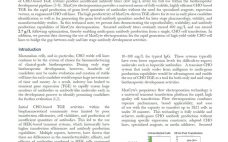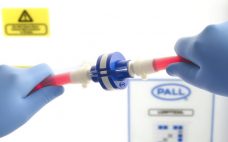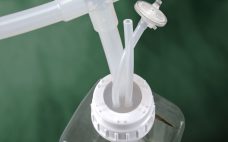In recent years researchers have turned to transient gene expression (TGE) as an alternative to CHO stable cell line production for early stage antibody development. Despite advances in transfection methods and culture optimization, the majority of CHO-based TGE systems produce insufficient antibody titers (low mg/L level) for full use within the biotherapeutic development pipelines. MaxCyte’s delivery platform for cell engineering is based on Flow Electroporation™ technology and provides a universal means of fully scalable, highly efficient CHO-based TGE for the…
Upstream
Continuous Processing Optimization With Smarter Tools
Single-use technology (SUT) has long been viewed as a viable solution to today’s biopharmaceutical manufacturing challenges. It offers the flexibility to change a production configuration to meet demand while also offering many other cost benefits, such as savings related to the elimination of clean-in-place (CIP) and sterilization-in-place (SIP) processes. However, traditional and fed-batch models fail when trying to adapt to single-use flexibility due to the required rewriting of code and revalidation. The best way to use the flexibility of single-use…
Multi-Gram Scale Antibody Production Using CHO Cell Transient Gene Expression (TGE) via Flow Electroporation™ Technology
Despite advances in transfection methods and culture optimization, many CHO-based TGE systems produce insufficient antibody titers (low mg/L level) for full use within biotherapeutic development pipelines. The high productivity of MaxCyte-driven transient gene expression allows for its use in early phase candidate identification as well as for generating the gram-level antibody quantities needed for later stage pharmacology, stability and manufacturing studies. In this white paper, data are presented demonstrating the reproducibility, scalability and antibody production capabilities of MaxCyte Flow Electroporation™…
Use of the ambr®250 in Combination with High-Throughput Design and Analysis Tools for Rapid, Scalable USP Development
There have been many recent advances in high throughput (HT) technologies for upstream development, enabling processes to be developed in a fraction of the time compared with conventional methods. However, when applying this technology to biotherapeutic drug development, the suitability of the systems for developing large scale manufacturing processes and meeting regulatory demands needs to be demonstrated and ensured. Inclusive approaches encapsulating platform expression systems and fermentation technologies, parallel bioreactor systems, high throughput analytics and sophisticated design and data handling…
Characterization and Engineering Performance of the Allegro™ STR 2000 Single-Use Stirred Tank Bioreactor
Process performance in bioreactors is strongly influenced by the efficiency of bulk fluid mixing and the oxygen mass transfer coefficient (kLa). The success of traditional stainless steel STR systems lies in their direct impeller driven agitation that can deliver a wide range of specific power inputs to the fluid. The Allegro™ range of single-use stirred tank bioreactors has adopted this direct driven impeller technology, which allows a wide range of specific power inputs to be achieved. In addition, modifications to…
New Genderless Sterile Connection Technology – A Quality By Design (QbD) Approach For Greater Sterility Assurance From Manufacturing To Use
Single-use pre-sterilized systems can potentially offer a higher level of sterility assurance and a lower risk of product contamination by eliminating some of the operational procedures of traditional processing. The importance of this benefit was highlighted by the FDA’s product recalls in 2015 where 78% of recalls were attributed to lack of sterility assurance or to contamination of the drug product, with the primary reason being failure to follow written procedures. A key requirement for multi-component, single-use sterile systems is…
How to Boost Profits with Single-Use Powder Transfer in Biopharmaceuticals Manufacturing
For many years, media and buffer ingredients used in powder form were transferred from stock containers using open scoops, weighed and mixed in buckets or open-top bags, and then carried in and dumped from those buckets or open-top bags directly into production vessels—based on the premise that sterility wasn’t required at that early stage of manufacturing. While much of this process was often carried out in a separate room from the production line to contain airborne contaminants, final transfer to…
Getting Big Benefits from Small Components
Like a chain, a biopharma transfer system depends on each of its links being strong enough to protect the integrity of the materials being transferred. In order to prevent problems associated with contamination, the system must be able to maintain a pure environment. Container closures and stopper systems are sometimes seen as small items, but choosing the right components is vital. The impact of specifying the appropriate closure or stopper system can be felt throughout an entire fluid transfer process.…
Modern Peptone Manufacturing: Raising the Standard for Fermentation Substrates
Peptones from the Solabia Group represent the result of nearly 50 years of strategic activity and savoir-faire. As key components in industrial fermentation, they contribute to a range of products, from probiotics and vaccines to specific bacterial metabolites in cosmetics. Although they are often perceived as replaceable commodities with similar sounding names, that misconception can lead to significant problems. Peptones differ in sourcing as a function of a producer’s manufacturing experience, raw materials, and (most important) production site itself and…
Ten Tips for Single-Use Biopharmaceutical and Pharmaceutical Tubing Selection
Tubing for Single-Use bioprocess and pharmaceutical applications has particular requirements. Among them are the ability to withstand various sterilization processes, the delivery of favorable test results regarding extractable substances, and the absence of animal-derived ingredients. Flexibility, permeability, performance in pumps, and welding and sealing capabilities are also common considerations. Additionally, these critical industries should be aware of the environment in which the tubing is manufactured, association standards that must be met and costs. One of the most important concerns involves…










